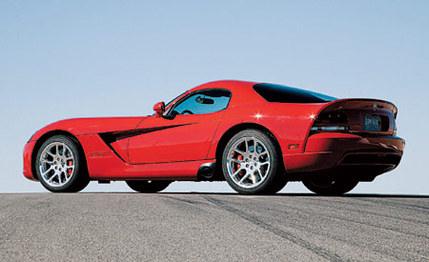 Road Test
Road Test
In an attempt to provide timely coverage of this new Viper coupe, we drove one away from the press introduction in Monterey, California. More specifically, we drove it about 500 miles south directly to our testing site in the high desert to get the numbers you see here in the spec panel. That's a long day, particularly in an ambient temperature of 100 degrees (which may account for the fractionally slower than expected test figures reflected here). We like to think it's all worth it if our readers get what they deserve.
Turns out we got what we deserved from this altruistic act, too. We got to drive the new Viper SRT10 coupe a long way in the high-speed world of highways and unpatrolled byways, through canyons and valleys and alongside the shining Pacific. After that, trolling the big coupe around in suburban Los Angeles felt like using a sledgehammer to swat a flea.
The fact of the matter is the Viper is a bit of an unruly animal in a city environment, where its grumbling 62-decibel idle and accompanying tremors are not the most restful companions at red lights. Although the shifter in our coupe had lightened and smoothed during the course of break-in and the clutch was always easy to use—blessed with a communicative, long engagement span—the driveline is prone to an occasional oscillating shuffle in stop-and-go traffic that gets so insistent you have to get on the clutch to quell it.
Some of the noises from the gearbox are pretty rude, too, at times, and you wonder if a couple pounds of noise-deadening liner might have helped. But then you recall driving the car at Mazda Raceway Laguna Seca, how it ran up the hill to the Corkscrew hard in third gear, the V-10 bellowing as its 500-hp rage poured down the driveshaft and clawed at the pavement through giant 14.0-inch-wide Michelins.
The bite of four big Brembo calipers pinching 14.0-inch rotors had the tail weaving slightly down the hill into Turn Two, where the nose would swing obediently into the first of the two apexes. Then a gradual squeeze on the accelerator (don't mash this car's throttle if you know what's good for you) pinned the tail for a big thrust down the road to Three. There's some power-induced rotation available at the pedal to help the car out of Two, but it isn't as pronounced as in the convertible Viper.
We tried that softtop car by way of comparison, and although the convertible is as much fun as ever, it likes to hang out its tail on the end of the engine's seemingly bottomless tide of torque. The similarities between the two Viper versions are obvious; the chassis are essentially identical. But the coupe was never a sure thing, according to SRT director Dan Knott, and the car was, after all, designed first as a convertible.
So the coupe gained some structural rigidity when the double-bubble roof went on, with a negligible change in weight. Which means the performance ought to be identical to that of the convertible, with 0-to-60 mph in 3.9 seconds and a quarter-mile in 12.1 seconds. Our car missed those benchmarks by 0.1 second and 0.4 second, respectively, but then again, we've never matched those early numbers in more recent tests of Viper roadsters.
In fact, Knott says the only body parts the Viper SRT10 coupe shares with the convertible are the front fascia and the fenders, hood, and doors. New to the coupe along with the new canopy and decklid are the rear quarter-panels, the windshield surround, the door side glass, the rear fascia, and the taillamps.
The big surprise to this six-foot-five tester is how much space there is inside the coupe. Although the windshield is close at hand and short in profile, the seating feels roomier than in the convertible, and there's enough space to accommodate a helmet. Perhaps it's the adjustable pedals that do it, abetting the already generous footbox to provide extra dancing room.
Whatever, the roof does not make the Viper any more claustrophobic than its topless fellow hatchling. It certainly makes the car more civilized while commuting along freeways in 100-degree heat, with the air-conditioned atmosphere trapped inside that composite cocoon. And the luggage space is much better than in the softtop Viper, with an additional four cubic feet of space. (The convertible has just two cubic feet under its trunklid.)